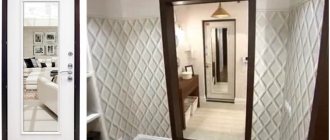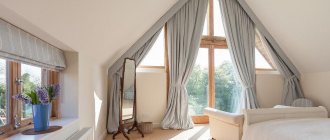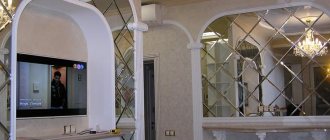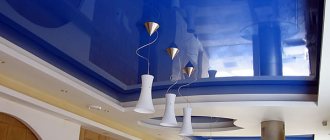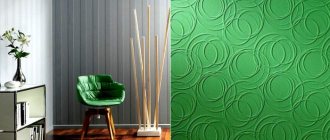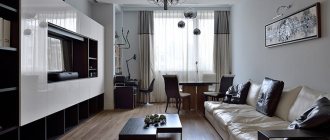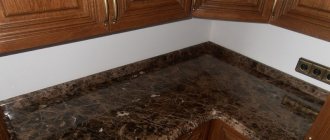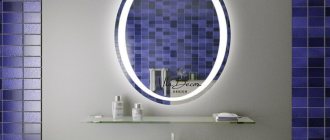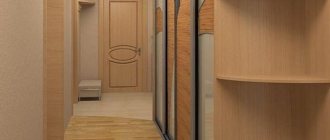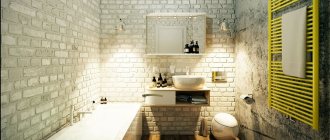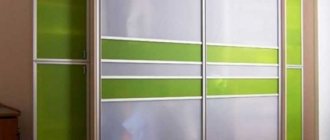No. 1. Choosing the type of mirror for the hallway
A hallway mirror can be one of the following types:
- wall;
- floor;
- element of furniture or decoration.
Wall mirrors are the most common type of mirror in a hallway. They can be framed or without a frame, and can be supplemented with a shelf at the bottom or other elements. A wall mirror can be vertical or horizontal . The first option is better, because it allows a person to see himself in full growth. An additional advantage is the property of making the room visually a little higher. The main thing is to hang the mirror level, otherwise you can get significant deformations in the reflection: if the upper part is located a little further from the wall than the lower one, then in the reflection the person will look somewhat slimmer. This is not bad, but it is misleading.
Unfortunately, not all hallways have enough space for a large full-length mirror, so you often have to be content with small options placed above the bedside tables. As a rule, these are horizontal canvases, which have their own advantages. Thus, they are able to visually expand the wall on which they are located, and therefore enlarge the hallway itself.
Floor mirrors must be framed and have a stand. They can be easily moved from place to place and the angle of inclination can be changed. This option is often used for spacious hallways, but for the most compact rooms it is an excellent option, because the mirror can be moved at any time.
An interesting option is to place a mirror that covers the entire wall : the expansion of the hallway space is guaranteed, and you can see your image in the smallest detail. This is an excellent option for long and narrow hallways , but you will have to regularly care for such a surface so that it does not lose its qualities.
A mirror can be part of the furniture and still do its job perfectly. Often the mirror is located on the cabinet door and becomes part of the finished design for the hallway. This is a convenient and functional option that will help save space and time when choosing a suitable mirror. wardrobe fits in the hallway , then its doors are often made mirrored. In this case, it is important to remember that mirrored doors are less durable than regular solid doors, so you should not lean on them.
Another interesting option is to use a mirror finish . This can be a mirror tile, which alternates with regular tiles, thereby forming an interesting interior, increasing the space and serving as a reflective surface, because a whole canvas can be formed from individual parts. Mirror tiles for the ceiling are, rather, a decorative technique, since in this case the mirror cannot perform a direct function.
Aged mirror
An antique mirror is perhaps the only antique item that does not enjoy special popular love. Firstly, lead impurities in cloudy amalgam are repelled. Secondly, folk superstitions do not recommend looking into other people’s mirrors of dead people.
Therefore, we propose to consider other types of mirrors that are relevant today, and let’s start with artificially aged ones. In appearance they cannot be distinguished from antiques, but to create a cloudy amalgam, their surface is rubbed with acid (safe for health!). Such mirrors in the interior make your reflection look like an old photo.
- 1 of 4
On the picture:
A cloudy mirror is not always a defect, just like a mirror made up of fragments.
Panoramic mirrors.
Panoramic mirrors in the interior are reflective surfaces covering the entire wall or part of it. Also called panoramic are spherical fisheye models that can reflect the entire room. Previously, these types of mirrors were used in jewelry stores as a “security camera.”
In the photo: Fiore D`acqua 12 from Altamarea.
No. 2 Mirror shape and size
A mirror in the hallway plays not only a purely functional role, but also a decorative one, and with its help you can decorate and highlight this room. The shape of the mirror surface is of great importance. Rectangular and square have become the most common , but if you want to achieve an interesting effect, you can opt for a mirror of irregular or non-standard shape .
Round mirrors also look very interesting in the hallway . Once upon a time, people believed that mirrors of this shape protected against the evil eye; the teachings of Feng Shui speak of their beneficial effect on energy, but if we discard all this, we simply get an interesting and unusual solution. With the right approach, a round mirror will generally look like a window, which is so missing in the hallway.
As for the size of the mirror, it is better, of course, that it be full-length. But in modern small hallways there is not always enough space for such an option - it is important to correctly assess the size of the room in advance in order to understand exactly what size mirror will fit exactly. The minimum dimensions for a mirror are 30*40 cm , with parameters of 40*60 cm you can already see yourself from the waist up, and a canvas measuring 60*120 will allow you to see yourself in full height.
If the hallway is very small , then you can use a horizontal wall mirror or a mobile floor mirror, which, if necessary, can be removed altogether. Also, a good option for compact hallways would be a ready-made set of furniture , which includes a wardrobe, a mirror, and all kinds of shelves. You can also use a mirror combined with another element, for example, a shelf for hats, a hanger, etc.
Description and characteristics of types of mirrors:
Aged look of the mirror
Antique mirror. It is very rarely in demand nowadays, although it would look great in a classic style. An aged mirror is repelled by the admixture of lead. And people who believe in omens prefer not to look in such old, centuries-old mirrors.
But the age of modern technology does not stand still. And today the current type of mirror is an artificially aged look of the mirror. The appearance of an artificial mirror is no different from an antique. Its surface is rubbed with acid, which is harmless to health.
Types of mirrors with internal lighting
This type of mirror has any shape, functionality and size, with internal lighting. The type of mirrors with internal lighting has a decorative and practical purpose. They will create successful lighting for cosmetic processes.
Related article: Bright refrigerator in the kitchen interior (45 photos)
A mirror with internal lighting is an effective way to enlarge a small room. It will make the space larger, because this type of mirror reflects the light that it itself emits.
An illuminated mirror is made using LED lighting, which is attached to the inside of the mirror. This type of mirror creates diffused light, which will add romance to the bedroom.
Multipart types of mirror
Multipart types of mirrors consist of individual mirrors or modular and interconnected. This mirror is used only for decorative purposes. Therefore, multi-part mirrors in the form of droplets, fragments or a broken mirror.
Faceted types of mirrors
It consists of many faces - facets that are capable of scattering the sun's rays. Facet is translated from French as “a separate plane of a faceted thing.”
This type of mirror can release sunbeams on your walls. The faceted look of mirrors is very popular in Venice.
Nowadays, the beveled look of mirrors has received a second life. They decorate the interior design of a children's room and living room.
Types of mirrors - shapes
Traditional forms of mirrors have long faded into the background and serve mainly a decorative function. Using shaped types of mirrors, you can create huge compositions that will not leave your guests indifferent. Such compositions can be made with small round mirrors, figures, leaves, flowers, animals and letters. Anything your imagination desires. As a rule, compositions of shaped types of mirrors, the figures are placed not far from each other. Such compositions of figured mirrors are suitable for transforming a living room. Such mirrors will also decorate the bathroom.
Basically, shaped types of mirrors are not framed, so as not to spoil the appearance of the figures, and this is technologically difficult.
Panoramic views of mirrors
Panoramic mirror surfaces expand the space. Typically, these types of mirrors are placed along the entire wall. The panoramic view of mirrors also includes a fish-eye mirror - this is a mirror surface with a convex surface.
Related article: Curtains with lambrequin: advantages, types and tips for choosing
Panoramic views of mirrors reflect the entire room. They are used in high-end stores to track customers. At the moment, the need for such mirrors has disappeared, since technology has stepped far forward.
Colored mirror
The colored mirror is made of polymer acrylic; it can also be simply coated with amalgam. It will help you see the world in any color. Therefore, this type of mirror is perfect for people who need rose-colored glasses.
Typically, emerald, gold, bronze, blue, gray and pink colors are used to cover mirrors. If you don’t have the color of the mirror you need, you can buy a film in the store and stick it yourself on a regular mirror.
Colored types of mirrors will help make a small room appear larger, so this is a good option for small spaces.
Types of crooked mirrors
Crooked mirrors come in a variety of forms. They can be in the form of a curving wave, break our silhouette into parts or show only one part of the body.
This type of mirror is intended for people who know how to laugh at themselves and their shortcomings. It is ideal for the design of a children's room, which will be filled with the constant laughter of your children.
Types of psiche mirrors
A psiche mirror is a type of mirror with a swaying reflective surface. Using the design of this mirror, it is possible to adjust the inclination of the reflecting surface.
This type of mirror was produced in 1790 and it came with a ladies' dressing table. A multi-shaped frame of a psyche mirror was mounted on a chest or table.
Then they came up with the idea of making psychedelic mirrors that would simply stand on the floor. At this time, the type of psiche mirror has become a separate element of the interior and is used as a cosmetic mirror. This type of mirror is often used in the Art Nouveau style.
Multifunctional types of mirrors
As you understand, mirrors can serve different functions. The use of mirrors in DIY furniture is quite well known (mirrors - clocks, mirrors - shelving).
Related article: How to use regular and wicker baskets in the interior (66 photos)
How to choose different types of mirrors correctly
Thicker is better
The thickness of the mirror should be 4 – 6 mm. The thicker the mirror, the better and, accordingly, more expensive it will be.
Perfect smoothness
When choosing a mirror, you should carefully inspect the mirrors. Mirrors with air bubbles, spots, unevenness or scratches will not be very pleasing to you and your home decor.
Through the Looking Glass
Look behind the back of the mirror. This is done to ensure that the protective coating does not have defects. If the reverse side of the mirror has defects, the mirror will lose its moisture-resistant and reflective properties. A good looking mirror should have 3 layers of coating - silver and two protective ones.
Coating
Silver film is the best coating. Aluminum mirror coating is also used.
Edge
The edge of any type of mirror must be smooth, without chips. Because the edge serves as protection for the layers of the mirror.
No. 3. Number of mirrors
There doesn’t have to be only one mirror in the hallway - you can create a whole composition from mirrors of different sizes and shapes . It is important that they are in the same style. You can use mirrors of the same size and place them on different walls so that you can examine yourself from all sides before leaving. This technique also allows you to visually expand the boundaries of the hallway. In any case, it is important not to overdo it, because multiple reflections and the looking-glass effect will not decorate the room.
Types of mirrors
Currently, mirrors are made on silver amalgam with several protective layers. First, the glass is covered with a special silver film (silver microfilm). Then the mirror surface is covered with a copper layer, which protects the silver film from moisture and mechanical stress and serves as the basis for applying the third layer - a polymer coating. For the production of colored mirrors
use glass tinted in the mass or a colored reflective layer. The most popular colors of mirrors include bronze, pink, graphite, gold, and blue.
Mirrors are very popular today, the decorative effect of which is achieved by using various techniques of engraving, silk-screen printing and matting the polished surface using sandblasting. Ecologically, new generation mirrors have the following distinctive abilities:
- metal (silver) coating that does not contain copper;
- lead-free protective primer;
- a level of quality that exceeds the requirements of all applicable standards;
- ability to withstand chemical damage;
- mirrors successfully pass the most important tests for standardization;
- unsurpassed anti-corrosion properties provide protection against aging and aggressive substances such as ammonia and acetic acid contained in a number of cleaning products;
- covering mirrors together with any adhesives, which simplifies their fixation for the user or builder;
- The appearance of corrosion and “clouds” over time is excluded.
Our company works with mirror fabrics made in Belgium. These mirror sheets have the following properties: - Moisture resistance and resistance to aggressive environments. - Perfect reflection. — Silver mirror coating. — Durability of the coating, absence of stains and tarnishing over time. — A wide range of colored mirrors - silver, bronze, graphite, green, blue, pink, moraine (“antique”), handmade artistic mirrors. Specifications:
— The thickness of the mirrors is from 3 to 6 mm. — minimum product dimensions – 70 x 70 mm — maximum product dimensions – 3210 x 2250 mm
ARTIFICIALLY AGING MIRRORS
The fashion for old things has not spared mirrors, which, despite their fragility, can survive centuries.
Ancient mirrors that have aged over time are very rare. Designers who decorate antique interiors understand this and turn to companies that skillfully age new mirrors for help. The quality of artificial aging is so high that only a professional can distinguish a real rarity from its modern counterpart. The effect of antiquity is emphasized not so much by the frame (faded and peeling in places), but by the amalgam. It should be dark, dull, speckled with black dots and patinated spots, like a naturally aging mirror. The peculiarity of artificially aged mirrors lies in their non-standard color palette. Various shades of canvases (silver, pink, green, purple, etc.) create bright and rich displays. Aged mirrors, which look like antiques, are of the same quality as models that demonstrate the achievements of modern technology.
A special method of artificially aging mirrors allows you to create a three-dimensional display effect. At the same time, the image quality remains at a very high level, without any distortion. And the durability of these “hundred-year-old” mirrors is guaranteed by the layered resin that is used to make the surface of the mirrors.
No. 4. Mirror style
If there are several mirrors in the hallway, even their different shapes and sizes are allowed. The main thing is that they are made in the same frames , due to which a composition effect reminiscent of an art gallery is achieved. Whatever one may say, the mirror must be in harmony with the entire space, complement it and successfully fit into the chosen interior style.
Thus, for a classic interior, mirrors in massive wooden or forged frames, in gilded frames with numerous curls, are suitable. For a high-tech or minimalist , a mirror in a plastic or smooth metal frame is suitable. A frame made of pebbles, shells or bamboo is an excellent complement to the nautical style , and the frameless option is suitable for the modern .
No. 5. Correct mirror lighting
Since the hallway is in 99% of cases a room without natural light, in order to see yourself in the mirror, it must be properly illuminated. It is desirable that in the hallway there is not only a general light source, but also a local one, which would directly illuminate the area near the mirror . A person standing in front of a mirror should be well and evenly illuminated in order to correctly assess his appearance before going out. For this you can use:
- Spotlights;
- symmetrical wall sconces;
- floor lamp;
- rotating lamps (spots).
In addition, LED strips , which are easy to install, consume minimal energy and last a long time, are also popular. But they are used mainly for decorative purposes, and a sufficient level of lighting is achieved thanks to the methods listed above.
Proper lighting and placement of mirrors and lamps can correct many of the shortcomings of the hallway. So, in a dark, narrow corridor, it is enough to hang a lamp on the wall opposite the mirror, and thanks to its reflection, you will get a hallway close to a square shape, filled with light.
No. 6. Mirror placement
Whatever the shape and size of the mirror in the hallway, it is important to place it so that there is enough space in front of it . This space is designed so that a person can calmly dress and examine himself.
It is best to place the mirror surface on a wall perpendicular to the wall with the front door. Placing a mirror directly opposite the front door is not the best solution, because immediately upon entering the apartment you will see a looming reflection in front of you. But there are exceptions: designers allow such placement of a mirror, provided that the hallway is very small and the person entering immediately bumps into the wall.
